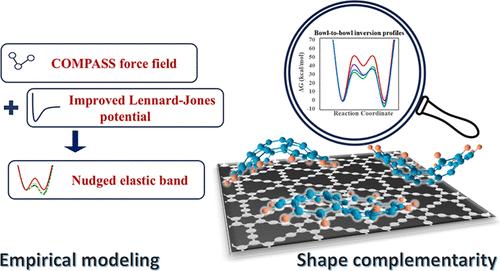Modeling the Inversion of Buckybowls on Graphynes for Shape-Complementary Catalysis
IF 3.2
3区 化学
Q2 CHEMISTRY, PHYSICAL
引用次数: 0
Abstract
Given the ubiquity of surface characterization techniques in recent years, shape-complementary catalysis that induces molecular reorganization on surfaces has attracted significant attention. Herein, we investigate the bowl-to-bowl inversion of buckybowls (corannulene, acecorannulylene, semibuckminsterfullerene, and acenaphtho[3,2,1,8-cdefg]benzo[5,6]-as-indaceno[3,2,1,8,7-mnopqr]chrysene (TWB)) adsorbed on graphene and γ-graphyne (γ-GY) membranes using atomistic potential modeling. The inversion profiles are characterized using the nudged elastic band approach, wherein intramolecular interactions are modeled using the COMPASS force field, and intermolecular interactions are described by an improved Lennard–Jones potential. The extent of shape-complementary catalysis is largely governed by the strength of the van der Waals interactions between the buckybowls and the substrates. Notably, the inversion barrier of corannulene is reduced from 9.2 kcal/mol in the gas phase to 5.86, 7.34, and 7.70 kcal/mol when bound to graphene, γ-GY-1, and γ-GY-2, respectively. For TWB, the inversion barrier follows the same trend and decreases from 122.65 to 101.33 kcal/mol upon graphene binding. The catalytic effectiveness of the investigated carbon membranes is governed by their carbon densities (graphene > γ-GY-1 > γ-GY-2). However, in the case of semibuckminsterfullerene, the porous nature of γ-GYs plays an important role in catalytic activity via partial accommodation of the twisted architecture of intermediate and transition states, resulting in a 35% reduction in the inversion barrier in γ-GY-2, highlighting porosity as a design parameter in shape-complementary catalysis. Our empirical methodology, validated against density functional theory for selected systems, offers a computationally efficient alternative to electronic structure methods for capturing inversion kinetics. These findings highlight the potential of GYs as tunable catalysts for molecular rearrangements and provide a practical framework for assessing surface-mediated catalysis.

形状互补催化的巴基碗在石墨烯上的转化模拟
鉴于近年来表面表征技术的普遍存在,诱导表面分子重组的形状互补催化引起了人们的极大关注。在此,我们利用原子势模型研究了吸附在石墨烯和γ-石墨炔(γ-GY)膜上的巴基碗(环烯、环烯、半环烯富勒烯和环萘[3,2,1,8-cdefg]苯并[5,6]-吲哚[3,2,1,8,7-mnopqr])的碗到碗转化。反演剖面采用微推弹性带方法进行表征,其中分子内相互作用采用COMPASS力场建模,分子间相互作用采用改进的Lennard-Jones势来描述。形状互补催化的程度在很大程度上取决于巴克碗和底物之间的范德华相互作用的强度。值得注意的是,当与石墨烯、γ-GY-1和γ-GY-2结合时,环烯烯的反转势垒分别从气相的9.2 kcal/mol降低到5.86、7.34和7.70 kcal/mol。对于TWB,反转势垒也遵循相同的趋势,在石墨烯结合后从122.65 kcal/mol降低到101.33 kcal/mol。所研究的碳膜的催化效能取决于它们的碳密度(石墨烯>; γ-GY-1 > γ-GY-2)。然而,对于半球形富勒烯来说,γ-GYs的多孔性通过部分调节中间态和过渡态的扭曲结构在催化活性中起着重要作用,导致γ-GY-2的反转势垒降低35%,突出了孔隙度作为形状互补催化的设计参数。我们的经验方法针对所选系统的密度泛函理论进行了验证,为捕获反转动力学提供了一种计算效率高的替代电子结构方法。这些发现突出了GYs作为分子重排可调催化剂的潜力,并为评估表面介导的催化提供了一个实用的框架。
本文章由计算机程序翻译,如有差异,请以英文原文为准。
求助全文
约1分钟内获得全文
求助全文
来源期刊

The Journal of Physical Chemistry C
化学-材料科学:综合
CiteScore
6.50
自引率
8.10%
发文量
2047
审稿时长
1.8 months
期刊介绍:
The Journal of Physical Chemistry A/B/C is devoted to reporting new and original experimental and theoretical basic research of interest to physical chemists, biophysical chemists, and chemical physicists.
 求助内容:
求助内容: 应助结果提醒方式:
应助结果提醒方式:


